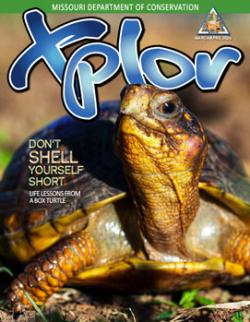
Xplor reconnects kids to nature and helps them find adventure in their own backyard. Free to residents of Missouri.


































Stay in Touch with MDC news, newsletters, events, and manage your subscription

Xplor reconnects kids to nature and helps them find adventure in their own backyard. Free to residents of Missouri.

A monthly publication about conservation in Missouri. Started in 1938, the printed magazine is free to residents of Missouri.
JEFFERSON CITY, Mo. – Missouri turkey hunters can expect this spring season to be about as challenging as the past few spring seasons according to the Missouri Department of Conservation (MDC). The spring turkey hunting season starts with a youth-only weekend April 10 and 11 followed by the regular spring season April 19 through May 9.
“A great deal of what makes for a good spring turkey season depends on the hatch two years prior because it affects the number of two-year-old gobblers on the landscape,” said MDC Turkey Biologist Reina Tyl. “These young gobblers are not associated with hens as often as older, more dominant birds and are the most likely to respond to hunters’ calls.”
According to MDC, turkey production was generally poor statewide in 2019. Therefore, hunters can expect fewer two-year-old gobblers available for harvest during this year’s spring hunting season.
“However, some regions of the state, especially north Missouri and counties along the Missouri River in central and east Missouri, saw significant improvements in production during 2020,” Tyl said. “It’s possible that hunters in those areas with better production last summer might see an overall increase in the number of turkeys on the landscape this spring due to an increase in the number of young birds.”
Considering the prospects for the 2021 spring season, hunters who aim to harvest a gobbler that is two-years-old or older should be prepared to put in a bit more effort to be successful this year.
“When gobbler numbers are down, it becomes even more important to spend time scouting for flocks before the start of the season,” Tyl said. “Hunters should get out to their hunting areas as much as possible to listen for birds gobbling at daybreak.”
Tyl noted that hunters should also take the time to learn where turkeys are spending most of their time after they fly down from the roost.
“Use binoculars to spot turkeys feeding in open areas or look for signs of where turkeys have been feeding in the timber,” she said. “This will help hunters be in the right area when the hunting season gets here.”
Although the prospects for this year’s spring season aren’t encouraging, this isn’t the first-time poor turkey production has reduced turkey numbers in Missouri. After reaching a population peak in the early-to-mid 2000s, Missouri’s turkey population experienced four years of poor production from 2007–2010, causing the population to decline. However, Tyl noted that turkey numbers rebounded following several years of improved production.
“In much of the state, we observed improved production during 2011, 2012, and 2014,” said Tyl. “As a result, turkey numbers increased, and hunters generally had better hunting seasons in the years that followed.”
She added, “We are again in a period of lower turkey abundance on a statewide scale driven by poor production in recent years. However, turkey numbers may start to rebound a bit in those regions of the state with improved production in 2020.”
GET MORE INFORMATION
Get detailed information on spring turkey hunting from MDC’s 2021 Spring Turkey Hunting Regulations and Information booklet, available from MDC offices and nature centers, other places where permits are sold, and online at huntfish.mdc.mo.gov/spring-turkey-hunting-regulations-and-information
For more information about spring turkey hunting, visit MDC’s website at huntfish.mdc.mo.gov/hunting-trapping/species/turkey
Buy Missouri hunting permits from numerous vendors around the state, online at mdc.mo.gov/buypermits, or through the MDC free mobile app -- MO Hunting -- available for download through Google Play for Android devices or the App Store for Apple devices.
HUNTER SAFETY
Tyl stressed that hunters can easily avoid the main cause of turkey-hunting incidents —mistaking or being mistaken by another hunter for wild game.
“Each year, most turkey hunting incidents typically involve hunters who fail to identify their targets,” said Tyl. “Unless you are certain that what you’re looking at is a wild turkey, remember that any movement you see or any sounds you hear while you’re hunting could be another hunter.”
She also advised hunters to wear some hunter-orange clothing when moving through the woods or fields, particularly when hunting public land.
“Bringing along an orange hat or vest is an easy way to stay safe”, said Tyl. “Wear one when you’re moving and put it away when you sit down to work a bird.”
Tyl also noted that many turkey hunting incidents involve members of the same hunting party. “If you’re hunting with someone else and you split up, be certain you know where your hunting partner will be at all times,” she advised.